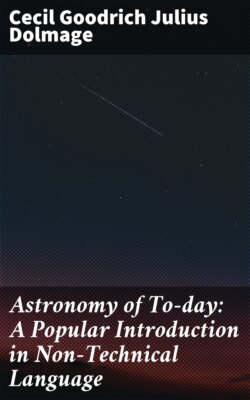Читать книгу Astronomy of To-day: A Popular Introduction in Non-Technical Language - Cecil Goodrich Julius Dolmage - Страница 20
На сайте Литреса книга снята с продажи.
ECLIPSES AND KINDRED PHENOMENA
ОглавлениеSince some members of the solar system are nearer to us than others, and all are again much nearer than any of the stars, it must often happen that one celestial body will pass between us and another, and thus intercept its light for a while. The moon, being the nearest object in the universe, will, of course, during its motion across the sky, temporarily blot out every one of the others which happen to lie in its path. When it passes in this manner across the face of the sun, it is said to eclipse it. When it thus hides a planet or star, it is said to occult it. The reason why a separate term is used for what is merely a case of obscuring light in exactly the same way, will be plain when one considers that the disc of the sun is almost of the same apparent size as that of the moon, and so the complete hiding of the sun can last but a few minutes at the most; whereas a planet or a star looks so very small in comparison, that it is always entirely swallowed up for some time when it passes behind the body of our satellite.
The sun, of course, occults planets and stars in exactly the same manner as the moon does, but we cannot see these occultations on account of the blaze of sunlight.
By reason of the small size which the planets look when viewed with the naked eye, we are not able to note them in the act of passing over stars and so blotting them out; but such occurrences may be seen in the telescope, for the planetary bodies then display broad discs.
There is yet another occurrence of the same class which is known as a transit. This takes place when an apparently small body passes across the face of an apparently large one, the phenomenon being in fact the exact reverse of an occultation. As there is no appreciable body nearer to us than the moon, we can never see anything in transit across her disc. But since the planets Venus and Mercury are both nearer to us than the sun, they will occasionally be seen to pass across his face, and thus we get the well-known phenomena called Transits of Venus and Transits of Mercury.
As the satellites of Jupiter are continually revolving around him, they will often pass behind or across his disc. Such occultations and transits of satellites can be well observed in the telescope.
There is, however, a way in which the light of a celestial body may be obscured without the necessity of its being hidden from us by one nearer. It will no doubt be granted that any opaque object casts a shadow when a strong light falls directly upon it. Thus the earth, under the powerful light which is directed upon it from the sun, casts an extensive shadow, though we are not aware of the existence of this shadow until it falls upon something. The shadow which the earth casts is indeed not noticeable to us until some celestial body passes into it. As the sun is very large, and the earth in comparison very small, the shadow thrown by the earth is comparatively short, and reaches out in space for only about a million miles. There is no visible object except the moon, which circulates within that distance from our globe, and therefore she is the only body which can pass into this shadow. Whenever such a thing happens, her surface at once becomes dark, for the reason that she never emits any light of her own, but merely reflects that of the sun. As the moon is continually revolving around the earth, one would be inclined to imagine that once in every month, namely at what is called full moon, when she is on the other side of the earth with respect to the sun, she ought to pass through the shadow in question. But this does not occur every time, because the moon's orbit is not quite upon the same plane with the earth's. It thus happens that time after time the moon passes clear of the earth's shadow, sometimes above it, and sometimes below it. It is indeed only at intervals of about six months that the moon can be thus obscured. This darkening of her light is known as an eclipse of the moon. It seems a great pity that custom should oblige us to employ the one term "eclipse" for this and also for the quite different occurrence, an eclipse of the sun; in which the sun's face is hidden as a consequence of the moon's body coming directly between it and our eyes.
The popular mind seems always to have found it more difficult to grasp the causes of an eclipse of the moon than an eclipse of the sun. As Mr. J.E. Gore[4] puts it: "The darkening of the sun's light by the interposition of the moon's body seems more obvious than the passing of the moon through the earth's shadow."
Eclipses of the moon furnish striking spectacles, but really add little to our knowledge. They exhibit, however, one of the most remarkable evidences of the globular shape of our earth; for the outline of its shadow when seen creeping over the moon's surface is always circular.
